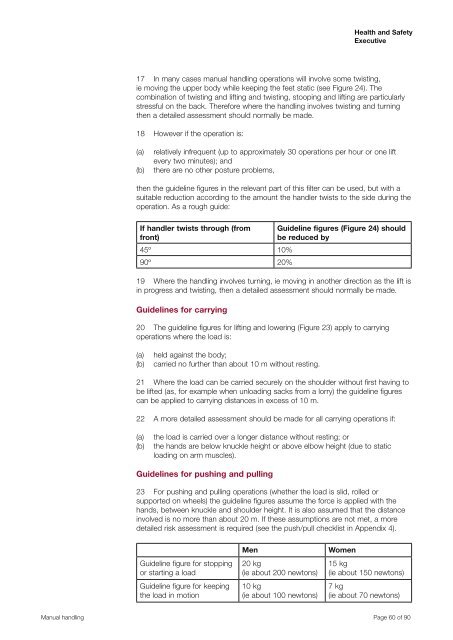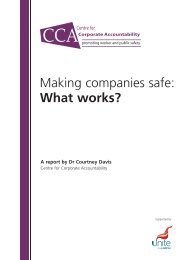Manual Handling Manual Handling Operations Regulations 1992 ...
Manual Handling Manual Handling Operations Regulations 1992 ...
Manual Handling Manual Handling Operations Regulations 1992 ...
Create successful ePaper yourself
Turn your PDF publications into a flip-book with our unique Google optimized e-Paper software.
Health and Safety<br />
Executive<br />
17 In many cases manual handling operations will involve some twisting,<br />
ie moving the upper body while keeping the feet static (see Figure 24). The<br />
combination of twisting and lifting and twisting, stooping and lifting are particularly<br />
stressful on the back. Therefore where the handling involves twisting and turning<br />
then a detailed assessment should normally be made.<br />
18 However if the operation is:<br />
(a)<br />
(b)<br />
relatively infrequent (up to approximately 30 operations per hour or one lift<br />
every two minutes); and<br />
there are no other posture problems,<br />
then the guideline figures in the relevant part of this filter can be used, but with a<br />
suitable reduction according to the amount the handler twists to the side during the<br />
operation. As a rough guide:<br />
If handler twists through (from<br />
front)<br />
45º 10%<br />
90º 20%<br />
Guideline figures (Figure 24) should<br />
be reduced by<br />
19 Where the handling involves turning, ie moving in another direction as the lift is<br />
in progress and twisting, then a detailed assessment should normally be made.<br />
Guidelines for carrying<br />
20 The guideline figures for lifting and lowering (Figure 23) apply to carrying<br />
operations where the load is:<br />
(a)<br />
(b)<br />
held against the body;<br />
carried no further than about 10 m without resting.<br />
21 Where the load can be carried securely on the shoulder without first having to<br />
be lifted (as, for example when unloading sacks from a lorry) the guideline figures<br />
can be applied to carrying distances in excess of 10 m.<br />
22 A more detailed assessment should be made for all carrying operations if:<br />
(a)<br />
(b)<br />
the load is carried over a longer distance without resting; or<br />
the hands are below knuckle height or above elbow height (due to static<br />
loading on arm muscles).<br />
Guidelines for pushing and pulling<br />
23 For pushing and pulling operations (whether the load is slid, rolled or<br />
supported on wheels) the guideline figures assume the force is applied with the<br />
hands, between knuckle and shoulder height. It is also assumed that the distance<br />
involved is no more than about 20 m. If these assumptions are not met, a more<br />
detailed risk assessment is required (see the push/pull checklist in Appendix 4).<br />
Guideline figure for stopping<br />
or starting a load<br />
Guideline figure for keeping<br />
the load in motion<br />
Men<br />
20 kg<br />
(ie about 200 newtons)<br />
10 kg<br />
(ie about 100 newtons)<br />
Women<br />
15 kg<br />
(ie about 150 newtons)<br />
7 kg<br />
(ie about 70 newtons)<br />
<strong>Manual</strong> handling Page 60 of 90
















